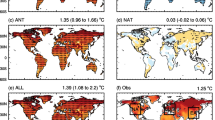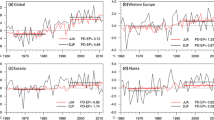Abstract
In this study, the contributions from changes in man-made greenhouse gases (GHG), anthropogenic aerosols (AA), and land use (LU), as well as natural solar and volcanic (NAT) forcing changes, to observed changes in surface air temperature (T) and precipitation (P) over global land, especially over arid-semiarid areas, during 1946–2005 are quantified using observations and climate model simulations from the Coupled Model Intercomparison Project Phase 5 (CMIP5). Results show that the anthropogenic (ANT) forcings dominate the ubiquitous surface warming seen in observations and lead to slight increases in precipitation over most land areas, while the NAT forcing leads to small cooling over land. GHG increases are the primary factor responsible for the anthropogenic climate change, while the AA forcing offsets a large part of the GHG-induced warming and P changes. The LU forcing generally contributes little to the T and P changes from 1946 to 2005 over most land areas. Unlike the consistent temperature changes among most model simulations, precipitation changes display a large spread among the models and are incomparable with the observations in spatial distributions and magnitude, mainly due to its large internal variability that varies among individual model runs. Using an optimal fingerprinting method, we find that the observed warming over land during 1946–2005 can be largely attributed to the ANT forcings, and the combination of the ANT and NAT forcings can explain about 85~95% of the observed warming trend over global land as well as over most arid-semiarid regions such as Northern China. However, the anthropogenic influences on precipitation over the past 60 years are generally undetectable over most land areas, including most arid-semiarid regions. This indicates that internal variability is still larger than the forced change for land precipitation.





Similar content being viewed by others
References
Allen MR, Ingram WJ (2002) Constraints on the future changes in the hydrological cycle. Nature 419:224–232
Allen MR, Stott PA (2003) Estimating signal amplitudes in optimal fingerprinting, part I: theory. Clim Dyn 21:477–491
Andrews T (2014) Using an AGCM to diagnose historical effective radiative forcing and mechanisms of recent decadal climate change. J Clim 27(3):1193–1209
Barnett TP, Pierce D, AchutaRao K et al (2005) Penetration of human-induced warming into the world’s oceans. Science 309:284–287
Becker A, Finger P, Meyer-Christoffer A et al (2013) A description of the global land-surface precipitation data products of the Global Precipitation Climatology Centre with sample applications including centennial (trend) analysis from 1901–present. Earth Syst Sci Data 5:71–99
Brovkin V, Boysen L, Arora VK et al (2013) Effect of anthropogenic land-use and land-cover changes on climate and land carbon storage in CMIP5 projections for the twenty-first century. J Clim 26:6859–6881
Brown AE, Zhang L, McMahon TA, Western AW, Vertessy RA (2005) A review of paired catchment studies for determining changes in water yield resulting from alterations in vegetation. J Hydrol 310:28–61
Chadwick R, Good P, Andrews T et al (2014) Surface warming patterns drive tropical rainfall pattern responses to CO2 forcing on all timescales. Geophys Res Lett 41:610–615
Charlson RJ, Schwartz SE, Hales JM et al (1992) Climate forcing by anthropogenic aerosols. Science 255:423–430
Chou C, Neelin JD (2004) Mechanisms of global warming impacts on regional tropical precipitation. J Clim 17:2688–2701
Dai A (2013a) Increasing drought under global warming in observations and models. Nat Clim Chang 3:52–58
Dai A (2013b) The influence of the inter-decadal Pacific oscillation on U.S. precipitation during 1923–2010. Clim Dyn 41:633–646
Dai A (2016) Historical and future changes in streamflow and continental runoff: a review. In: Tang Q, Oki T (eds) Chapter 2 of terrestrial water cycle and climate change: natural and human-induced impacts, Geophysical monograph, vol 221. AGU, Wiley, New York, pp 17–37
Dai A, Zhao T (2016) Uncertainties in historical changes and future projections of drought. Part I: uncertainties in estimating historical drought changes. Clim Chang. doi:10.1007/s10584-016-1705-2
Dai A, Fyfe JC, Xie S-P et al (2015) Decadal modulation of global surface temperature by internal climate variability. Nat Clim Chang 5:555–559
Deng Y, Gao T, Gao H et al (2014) Regional precipitation variability in East Asia related to climate and environmental factors during 1979-2012. Sci Rep 4:5693. doi:10.1038/srep05693
Deser C, Phillips AS, Bourdette V, Teng H (2012) Uncertainty in climate change projections: the role of internal variability. Clim Dyn 38:527–546
Dong B, Dai A (2015) The influence of the inter-decadal Pacific oscillation on temperature and precipitation over the globe. Clim Dyn 45:2667–2681
Feng H, Zhang M (2015) Global land moisture trends: drier in dry and wetter in wet over land. Sci Rep 5:18018
Gillett NP, Zwiers FW, Weaver AJ et al (2003) Detection of human influence on sea level pressure. Nature 422:292–294
Gillett NP, Arora VK, Matthews D et al (2013) Constraining the ratio of global warming to cumulative CO2 emissions using CMIP5 simulations. J Clim 26:6844–6858
Guan X, Huang J, Guo R et al (2015) Role of radiatively forced temperature changes in enhanced semi-arid warming in the cold season over east Asia. Atmos Chem Phys 15:13777–13786
Guo L, Highwood EJ, Shaffrey LC et al (2012) The effect of regional changes in anthropogenic aerosols on rainfall of the East Asian summer monsoon. Atmos Chem Phys Discuss 12:23007–23038
Harris I, Jones PD, Osborn TJ et al (2014) Updated high-resolution grids of monthly climatic observations—the CRU TS3.10 Dataset. Int J Climatol 34:623–642
Haywood JM, Boucher O (2000) Estimates of the direct and indirect radiative forcing due to tropospheric aerosol: a review. Rev Geophys 38:513–543
Huang J, Guan X, Ji F (2012) Enhanced cold-season warming in semi-arid regions. Atmos Chem Phys 12:5391–5398
IPCC (2014) Climate change: synthesis report. Contribution of Working Groups I, II and III to the Fifth Assessment Report of the Intergovernmental Panel on Climate Change. [Core Writing Team, Pachauri RK, Meyer LA (eds)] IPCC, Geneva, p151
Jiang SH, Ren LL, Yong B et al (2011) Quantifying the effects of climate variability and human activities on runoff from the Laohahe basin in northern China using three different methods. Hydrol Process 25:2492–2505
Jones GS, Stott PA, Christidis N (2013) Attribution of observed historical near surface temperature variations to anthropogenic and natural causes using CMIP5 simulations. J Geophys Res 118:4001–4024
Kendall MG (1975) Rank correlation measures. Charles Griffin, London
Kumar S, Dirmeyer PA, Merwade V et al (2013) Land use/cover change impacts in CMIP5 climate simulations: a new methodology and 21st century challenges. J Geophys Res 118:6337–6353
Li C, Zhao T, Ying K (2016) Effects of anthropogenic aerosols on temperature changes in China during the twentieth century based on CMIP5 models. Theor Appl Climatol 125:529–540
Liu Z (2012) Dynamics of interdecadal climate variability: a historical perspective. J Clim 25:1963–1995
Mann HB (1945) Non-parametric tests against trend. Econometrica 13:245–259
Mata LJ (2008) Influence of climate change on droughts and water scarcity in dry regions. The World Bank, Washington DC
Mehran A, AghaKouchak A, Phillips TJ (2014) Evaluation of CMIP5 continental precipitation simulations relative to satellite-based gauge-adjusted observations. J Geophys Res Atmos 119:1695–1707
Min SK, Zhang X, Zwiers FW (2008) Human-induced arctic moistening. Science 320:518–520
Min SK, Zhang X, Zwiers FW et al (2011) Human contribution to more-intense precipitation extremes. Nature 470:378–381
Mueller B, Zhang XB (2016) Causes of drying trends in northern hemispheric land areas in reconstructed soil moisture data. Clim Chang 134:255–267
O'Gorman PA (2015) Precipitation extremes under climate change. In: Sobel A, Camargo SJ (ed) Extreme events, current climate change reports, 1 (2):49–59
Prein AF, Langhans W, Fosser G et al (2015) A review on regional convection-permitting climate modeling: demonstrations, prospects, and challenges. Rev Geophys 53(2):323–361
Ramanathan V, Carmichael G (2008) Global and regional climate changes due to black carbon. Nat Geosci 1:221–227
Ribes A, Terray L (2013) Application of regularised optimal fingerprinting to attribution. Part II: application to global near-surface temperature. Clim Dyn 41(11–12):2837–2853
Ribes A, Planton S, Terray L (2013) Application of regularised optimal fingerprinting to attribution. Part I: method, properties and idealised analysis. Clim Dyn 41(11–12):2817–2836
Santer BD, Wehner MF, Wigley TML et al (2003) Contributions of anthropogenic and natural forcing to recent tropopause height changes. Science 301:479–483
Séférian R, Ribes A, Bopp L (2014) Detecting the anthropogenic influences on recent changes in ocean carbon uptake. Geophys Res Lett 41:5968–5977
Stott PA (2003) Attribution of regional-scale temperature changes to anthropogenic and natural causes. Geophys Res Lett 30:1724. doi:10.1029/2003GL017324
Stott PA, Gillett NP, Hegerl GC, Karoly DJ, Stone DA, Zhang X, Zwiers F (2010) Detection and attribution of climate change: a regional perspective. WIREs Clim Change 1:192–211
Sun Y, Zhang X, Zwiers FW (2014) Rapid increase in the risk of extreme summer heat in Eastern China. Nat Clim Chang 4:1082–1085
Sun Y, Zhang X, Ren G et al (2016) Contribution of urbanization to warming in China. Nat Clim Chang 6:706–709
Taylor KE, Stouffer RJ, Meehl GA (2012) An overview of CMIP5 and the experiment design. Bull Am Meteor Soc 93:485–498
Trenberth KE, Dai A, van der Schrier G et al (2014) Global warming and changes in drought. Nat Clim Chang 4:17–22
Wentz FJ, Ricciardulli L, Hilburn K et al (2007) How much more rain will global warming bring? Science 317:233–235
Zhang X, Zwiers FW, Hegerl GC et al (2007) Detection of human influence on twentieth century precipitation trends. Nature 448:461–465
Zhang X, Wan H, Zwiers FW et al (2013) Attributing intensification of precipitation extremes to human influence. Geophys Res Lett 40:5252–5257
Zhao T, Dai A (2015) The magnitude and causes of global drought changes in the 21st century under a low–moderate emissions scenario. J Clim 28:4490–4512
Zhao T, Dai A (2016) Uncertainties in historical changes and future projections of drought. Part II: model-simulated historical and future drought changes. Clim Chang. doi:10.1007/s10584-016-1742-x
Zhao T, Chen L, Ma Z (2014) Simulation of historical and projected climate change in arid and semiarid areas by CMIP5 models. Chin Sci Bull 59(4):412–429
Zwiers FW, Zhang X, Feng Y (2011) Anthropogenic influence on long return period daily temperature extremes at regional scales. J Clim 24:296–307
Acknowledgments
The authors are grateful to Dr. Aiguo Dai from the University at Albany-SUNY for his valuable suggestions to improve this manuscript. We thank Prof. Ribes Aurélien from National Centre for Meteorological Research for sharing the program of regularized optimal fingerprinting algorithm. We acknowledge the modeling groups and the CMIP5 projects for making the model data available. This work was supported by grants from the National Basic Research Program of China (2016YFA0600402 and 2012CB956203) and National Natural Science Foundation of China (41675094, 41605066, and 41405090).
Author information
Authors and Affiliations
Corresponding author
Additional information
This article is part of a Special Issue on “Decadal Scale Drought in Arid Regions” edited by Zong-Liang Yang and Zhuguo Ma
Electronic supplementary material
ESM 1
(DOCX 1316 kb)
Rights and permissions
About this article
Cite this article
Li, C., Zhao, T. & Ying, K. Quantifying the contributions of anthropogenic and natural forcings to climate changes over arid-semiarid areas during 1946–2005. Climatic Change 144, 505–517 (2017). https://doi.org/10.1007/s10584-017-2028-7
Received:
Accepted:
Published:
Issue Date:
DOI: https://doi.org/10.1007/s10584-017-2028-7




